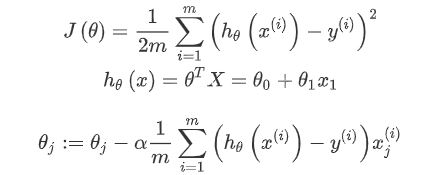吴恩达机器学习课后作业--ex1
单变量的线性回归
问题:在ex1data1.txt中有两列数据,第一列是城市人口数量,第二列是该城市小吃店利润,目的是根据城市人口数量来预测小吃店的利润
需要用到的公式

实现
import numpy as np import pandas as pd import matplotlib.pyplot as plt
numpy用来进行矩阵的运算,pandas常用来进行数据的操作,matplotlib主要用来可视化
读取数据集
path= "D:\\ML\\ML\\Linear Regression with One Variable\\ex1data1.txt" data = pd.read_csv(path,header=None,names=['Population','Profit'])#文件读取 data.head()#显示数据 data.plot(kind='scatter',x='Population',y='Profit',figsize=(12,8)) plt.show()
计算损失函数J(Ѳ)
def computeCost(X,y,theta): inner = np.power(((X*theta.T)-y),2) return np.sum(inner)/(2*len(X))
对数据集进行处理
data.insert(0,'Ones',1)#在第0列插入1,列名为Ones #初始化变量X和y #data.shape输出(行数,列数),所以shape[1]就为列数 cols = data.shape[1]#计算列数 #[起始行:终止行,起始列:终止列] X = data.iloc[:,:-1]#除最后一列 iloc是前闭后开,从0开始,提取指定行和列 y = data.iloc[:,cols-1:cols]#最后一列 X = np.matrix(X.values) y = np.matrix(y.values) theta = np.matrix(np.array([0,0]))#array转matrix,具体看array和matrix的区别
梯度下降算法
def gradientDescent(X,y,theta,alpha,iters): temp = np.matrix(np.zeros(theta.shape)) parameters = int(theta.ravel().shape[1])#ravel扁平化操作变成一维,计算参数的个数 cost = np.zeros(iters) for i in range(iters): error = (X*theta.T)-y for j in range(parameters): term = np.multiply(error,X[:,j]) temp[0,j] = theta[0,j]-((alpha/len(X))*np.sum(term)) theta = temp cost[i] = computeCost(X,y,theta) return theta,cost
设置学习率和迭代次数并执行
alpha = 0.01 iters = 1500 g,cost = gradientDescent(X,y,theta,alpha,iters)
可视化
#可视化 x = np.linspace(data.Population.min(), data.Population.max(), 100) f = g[0, 0] + (g[0, 1] * x) fig, ax = plt.subplots(figsize=(12,8))#拟合曲线 ax.plot(x, f, 'r', label='Prediction') ax.scatter(data.Population, data.Profit, label='Traning Data') ax.legend(loc=2) ax.set_xlabel('Population') ax.set_ylabel('Profit') ax.set_title('Predicted Profit vs. Population Size') plt.show() plt.plot(range(0,1500),cost) plt.show()
pandas:
pd.read_csv(filename):从CSV文件导入数据
data.head(n)默认显示数据的前5行
data.plot(kind='scatter',x='Population',y='Profit',figsize=(12,8))画图
data.shape() 获取data的行数和列数,是一个元组
data.shape[1] 得到data的列数
data.iloc[:,:-1] 获取data的部分数据,里面的含义是[起始行:终止行,起始列:终止列],包含的数据是前闭后开
data.insert(0,'Ones',1) 在第0列插入,值为1
numpy:
np.power(data,2) 对矩阵中的元素求平方
np.sum(data)对矩阵中的元素求和
np.matrix(X.values)转化为矩阵
data.ravel()对数据进行扁平化
np.multiply对应位置相乘,*是矩阵乘法
x = np.linspace(data.Population.min(), data.Population.max(), 100)生成元素个数为100的等间隔数列。而前两个参数分别是数列的开头与结尾。



 浙公网安备 33010602011771号
浙公网安备 33010602011771号